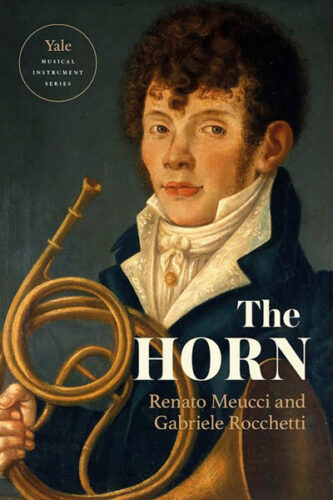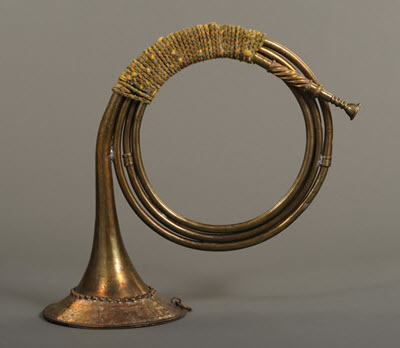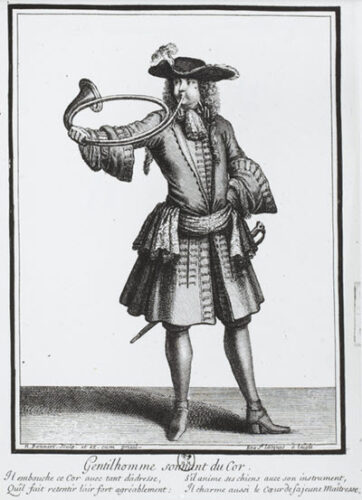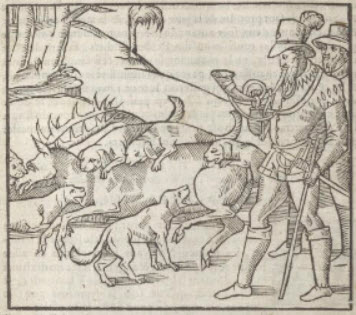by Richard Seraphinoff
Published October 14, 2024
The Horn by Renato Meucci and Gabriele Rocchetti. Yale University Press, 2023. 378 pages (plus online notes and appendices).
Many of the best-known books on the history of the horn are now more than 50 years old, including classics such as The French Horn by Reginald Morley-Pegge (1960) and The Horn and Horn Playing, and the Austro-Bohemian Tradition by Horace Fitzpatrick (1970). Since then, several excellent books have appeared that focus on specific periods or schools of horn playing, but, by 2023, the horn community was ready for the next comprehensive, all-encompassing book on the instrument’s history.

Historian and writer Renato Meucci is director of the Cultural Heritage Department of the Accademia Nazionale di Santa Cecilia in Rome, and Gabriele Rocchetti is professor of horn at the Conservatory Luca Marenzio and a professional horn player who performs extensively on both modern and historical horns. These co-authors have risen to the challenge of writing this next-generation book on the horn’s development, its playing technique, musical uses, and players. For the Yale Musical Instrument Series, they have produced a well-researched overview from the perspective of both the scholar and the performer.
With the accessibility of information, music, and documentation online today, the authors were able to unearth much new information and paint an even clearer picture of the horn’s rich history than was possible in previous books. An aspect that would not have been possible in earlier times is the inclusion of online appendices and notes through links to the Yale University Press website. This 21st-century mixture of 378 pages of printed text and 238 pages online made it possible to include much valuable information that might have been omitted from a traditional print-only book. (Let’s hope the URL, and the online information, lasts as long as the printed book sitting on a shelf.)
The Horn is organized in three sections: natural horn, natural horn made chromatic through hand-stopping and crooks, and valve horn. Using short, concise chapters to discuss various geographical areas, composers, and types of instruments, part one documents the earliest forms of the horn. It starts with Roman military instruments and moves quickly through the hunting and signaling horns of medieval times up to the 16th and 17th centuries and the first on-stage use of the horn in opera before it was integrated into the actual orchestral score.

This part continues into the 18th century and the development of the natural horn, still confined to the natural harmonic series for the most part, as it became a part of the orchestra and other musical settings. In addition to much new information, the two Italian authors were able to delve into the horn’s use in opera and orchestral music in Italy far more than previous writers.
Part two moves on to the middle of the 18th century when the horn became a more sophisticated instrument through the development of crooks and the technique of hand stopping, which enabled the player to fill in the gaps of the harmonic series and play chromatically. This opened up a new world of possibilities for solo and chamber music, making the horn a popular solo instrument in the second half of the century. The authors follow the horn’s trajectory through this period with sections on composers, types of music, contributions of prominent players, and the continued refinements of design of the instrument.

Having effectively documented this second period, the authors devote part three to the development of valves and the fully chromatic horn. They cover the experimental designs and patents that arose as the valve horn went through its evolution and growing pains through the 19th century, resulting in the current designs of the modern valve horn. This section details the repertoire for the horn in its musical settings of orchestra, wind bands, solo, chamber music, and even jazz and film scores, touching on important composers and compositions along the way.
The extensive bibliography will be of interest to horn scholars who want to dig deeper into the subjects discussed. This particular group will appreciate the authors’ treatment of some of the controversial questions of period-horn performance practice. For example, they consider the instruments and techniques used to play Bach’s horn parts, and the question of whether horns in the keys of C and B flat in Haydn were meant to be crooked in the higher octave, in unison with the trumpets, or an octave lower. The online appendices delve deeper into these specialized questions and will certainly supply material for future researchers to build on and discuss.

(Bibliothèque nationale de France)
One of the few points of criticism of the book might be a few instances of non-idiomatic usage of English. While always correct and understandable, the text includes some awkward word choices. A passage on early horn bell construction illustrates the point: “[the maker] …then wrapped it [the sheet metal pattern] on a mold of wood or iron corresponding to the desired shape. In this case, one of the two flaps was teethed and the other inserted between the indents to make the joint more solid.” Better wording might have been “…then wrapped it around a wooden or iron mandrel corresponding to the internal dimensions of the bell. Teeth were then cut into one edge of the pattern and the other edge was inserted between the teeth to make the joint stronger.” A brief consultation with an instrument-maker might have provided the authors with this more usual terminology.
But these are truly minor points. The book is very well written, and throughout, no concept or meaning is ever lost or at risk of being misunderstood. All told, this is a monumental work that will give both the general reader and the specialist a deeper understanding and appreciation of this beloved instrument and its colorful history.
Richard Seraphinoff is professor of horn and natural horn at the Indiana University Jacobs School of Music. He has performed and recorded extensively on both modern and natural horn, has written books and articles on horn subjects, including a recent historical novel, and is a well-known maker of reproductions of Baroque, Classical, and Romantic horns.




